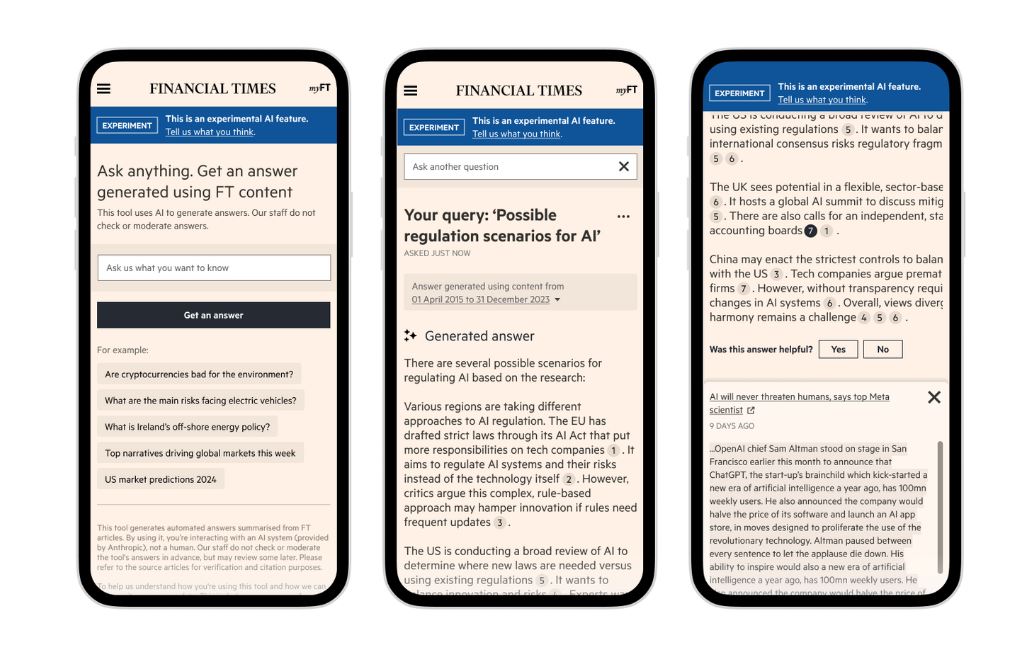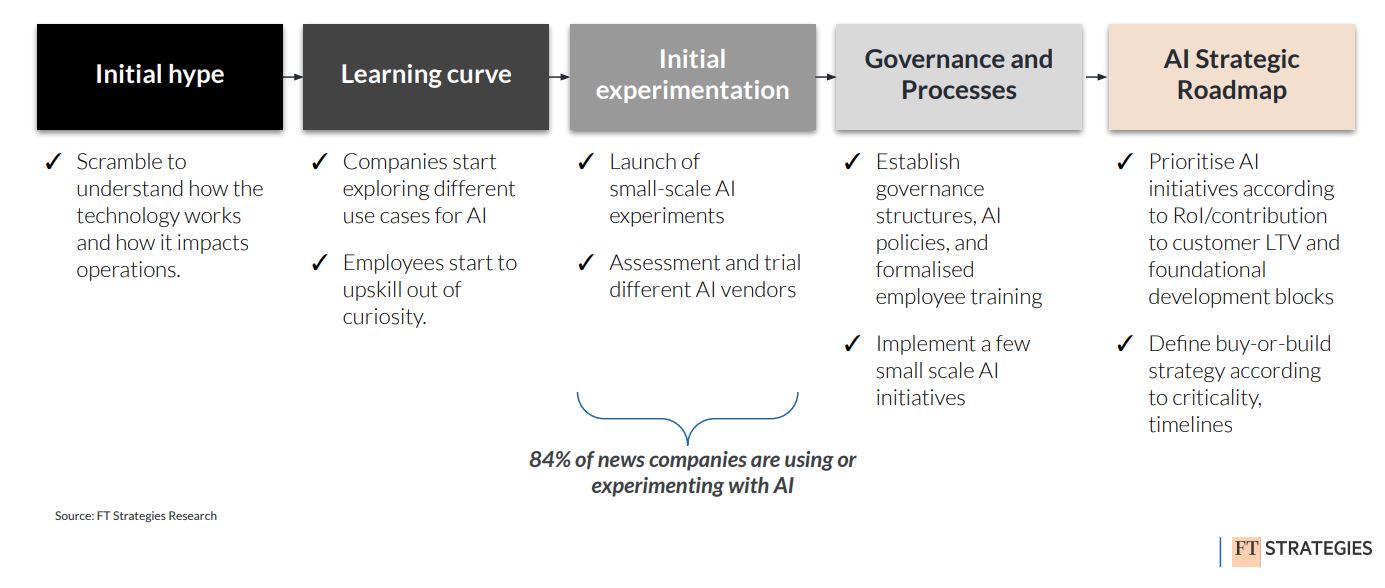I don’t know about you but, from time to time, I get a little weary of the AI hype train.
It’s like teenagers exaggerating their romantic experiences, claiming numerous conquests despite having none. It’s the same with companies boasting about supposedly being on top of AI..
Just like teens learn from their experiences (the good, the bad and the awkward), media companies need to figure out AI, learn how to use it right, and apply it to solve real problems or boost productivity. As companies get more comfortable with AI, they’ll move past just using it for the sake of using it and focus on how it can genuinely make their operations better.
That’s what we’ll be talking about at the AI panel at the Flashes & Flames “Monetising B2B Information and Events Conference” in London on 20 May.
In preparation earlier this week for our panel discussion on AI, I caught up with the two panellists who will join me on stage for a deep dive into practical applications of AI in business; Amir Malik, Managing Director EMEA for Alvarez & Marsal, and Adriana Whitely from FT Strategies, to get some direct insights into the AI implementation work they are leading for media brands. I also spoke with Angie Ma, Co-Founder of Faulty AI, who shared some fascinating practical insights learned over 10 years in the business of deploying technology-led solutions for some of the UK’s most important institutions including the UK Government and the National Health Service.
In this piece, I am ditching the hype in order to focus on the practical stuff that actually makes a difference. Here’s a sneak peak into some of their invaluable highlights which we will be sharing at Monetising B2B:
Starting with FT Strategies which is well known in the UK and US for helping media brands navigate transformation and technological change. About a year ago, it launched its own generative AI tool, AskFT.
I asked Adriana about the reasons for developing it, as well as successes and key learnings so far
Adriana: “AskFT is designed to assist FT Professional subscribers by providing them with quick access to relevant information from the FT’s extensive archives. The tool works by identifying semantically similar article segments to a user’s question and then using a large language model (LLM) to summarise these segments into a concise answer. This approach not only helps users quickly grasp complex topics but also ensures that the information is grounded in trusted FT content, complete with citations to the original articles.

“The primary objective behind the development of AskFT was to enhance the value proposition for its professional subscribers. Our aim was to create a tool that would help users better understand emerging news contexts and quickly gain insights into new companies or clients. This aligns with the broader trend in media, where publishers are experimenting with AI-driven chatbots to offer dynamic reader experiences. Other examples include Ask Skift and Forbes’ Adelaide; both of which are practical examples of a shift towards more interactive and personalised content delivery.
“A key challenge in developing AskFT was managing the risks associated with generative AI, such as hallucinations – where models produce information not grounded in reality. To mitigate these risks, the FT employed a model-agnostic approach, testing multiple models to find the best fit for their needs. They also emphasise transparency with users, clearly indicating that answers are machine-generated and not fact-checked.
The initial feedback from AskFT’s beta testing has been promising, with 75% of users finding the tool helpful. The FT is now focusing on integrating AskFT more seamlessly into users’ workflows, enhancing features such as search saving and answer refinement. This evolution underscores the importance of continuous user feedback in refining AI tools to meet real-world needs.

“In general, we think about technology deployment as a framework, and we typically support and advise businesses with the strategy, governance & processes and delivery of a roadmap to take them to where they want to get to”.

My second conversation last week was with Angie Ma, Co-Founder of Faculty AI.
Faculty is one of Europe’s leading applied AI companies; they have advised and supported organisations through major digital transformations, including Beazley (A FTSE 100 business; one of the world’s leading specialty commercial insurers), the UK National Health Service, Novartis and the UK Government. Faculty AI has just celebrated its10-year anniversary.
I asked Angie for a key lesson she’s learned over the past decade, and of a common danger to be avoided.
Angie: “A key lesson and piece of advice I now always recommend is to Build in increments that are individually valuable and collectively transformative.
“What we’ve seen consistently over the years is that unambitious Al programmes usually underwhelm. Don’t just focus on low-hanging fruit. Or on single use cases. That’s not how you make a measurable difference to the overall performance of an organisation. At the same time, over-ambitious Al programmes usually underdeliver too. It is very risky to try and imagine the whole future at once and seek a big bang. The right balance is to think big, but build forwards in modular steps. Each individual module should be quick to implement and valuable on its own terms. But modules should also be designed so that when connected together, they transform a whole process end to end.
“The operational decisions that determine how a business process runs make good targets for individual modules. Improvements to the speed, quality and execution of decision-making are one of the most reliable ways in which AI can improve the overall performance of a business process
“Connecting these individual decisions together allows them to break out of organisational silos and better account for upstream and downstream interactions. This shifts focus from what is best for each local part of the process to what is best overall.
“As for a danger to watch out for, one I would say that’s all too common, is AI pilotitis. It was a phrase coined by The Economist and should be avoided at all costs.
Al pilotitis is an affliction where too many small Al projects make it hard to identify where to invest. Afraid of being left behind by the Al hype, companies launch a flurry of ballyhooed Al initiatives, then quietly abandon them when the promised transformation fails magically to appear”.
Next up, I met up with Amir Malik, Managing Director EMEA for Alvarez & Marsal.
Amir has been leading digital transformation projects for more than 15 years and has a deep wealth of knowledge and experience of how AI can help accelerate business strategy.
We discussed a broad range of topics, which we’ll come back to on 20 May, but there was one area that Amir talked about which is particularly well suited to B2B media and information. Hyper-Personalised Automated Agents.

Here’s some of what Amir had to say about the emergence and application of Hyper-Personalised Automated Agents. (HPA Agents)
“When it comes to staying on top of industry developments, we’ve all been there – scrolling through endless reports, trying to find insights that really matter for our businesses. That’s where HPA agents come in, revolutionising the way we can discover relevant content, information and insights with hyper-personalised efficiency. Deploying AI-powered HPA agents brings five distinct advantages over traditional tools:
1. Autonomy and adaptability
HPA agents are like smart business analysts working independently, making real-time decisions without explicit instructions. They quickly adapt to changing market landscapes and your evolving business interests. Unlike traditional tools with static rules, these AI agents learn from your interactions, becoming more attuned to your industry focus daily.
2. Hyper-Personalisation
Imagine getting updates on supply chain disruptions, competitor movements, or regulatory changes tailored specifically for your vertical. An HPA agent can analyse your organisation’s priorities and market context to deliver intelligence that matters most. Traditional tools use basic keyword filtering, but HPA Agents can be trained to understand the nuances of your business interests.
3. Efficiency and scalability
B2B intelligence can be overwhelming. We’ve deployed HPA agents into businesses which process vast amounts of data in seconds and summarise complex market reports into actionable insights. In the context of a busy B2B new-gathering operation, it does much of the heavy lifting involved to ensure that the editorial teams stay informed without drowning in information. Where traditional content aggregation tools struggle can struggle with the sheer volume and relevance of industry news an HAP agent can handle it effortlessly.
4. Dynamic content curation
These AI agents predict emerging industry trends and categorise information on the fly. You get timely updates on developments impacting your sector. Traditional tools often rely on manual updates, leaving you with less relevant content about your vertical.
5. Integration with Multiple Sources
HPA agents can tap into diverse sources – from industry conference transcripts, specialised podcasts and professional networks to technical papers and complex data – giving you a comprehensive market view that traditional tools simply can’t match. In short, HPA agents could end up being powerful B2B intelligence sidekicks – smarter, faster, and more personalised than traditional tools for organisations looking to stay ahead of the industry curve.




